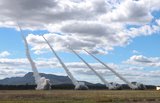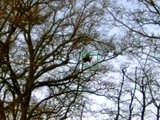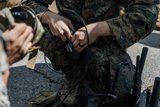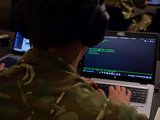Quad A 2011: Raytheon joins race for next-generation PCAS
Raytheon has been selected by the US Defense Advanced Research Projects Agency (DARPA) to compete with Northrop Grumman in the development of its Persistent Close Air Support (PCAS) initiative, designed to improve coordination between Joint Terminal Attack Controllers (JTACs), airborne sensors and weapons.
As exclusively revealed by Shephard (Unmanned Vehicles April/May 2011), the company has been awarded a $7 million contract which will see it go head-to-head with Northrop Grumman as mission systems integrator. The programme is due to run for a total of four years, although this first phase contract encompasses an 18-month lead up to a Preliminary Design Review. DARPA is then expected to down-select either Northrop Grumman or Raytheon to continue with the second phase.
David Bossert, engineering fellow for unmanned systems at Raytheon told Shephard at the Quad A annual exposition that the programme was designed to complement the 'next-generation JTAC'. He also described how the company would be looking to improve JTAC interfaces; levels of autonomy for weapons effect and routing of UAS; as well as on-board processing.
Raytheon also confirmed that the Fairchild A-10 Thunderbolt II or 'Warthog' would be the selected vehicle for the programme, with partnering company Proxy Aviation Systems upgrading it into an OPV. Rockwell Collins and GE Aviation are also partnering Raytheon to integrate JTAC equipment and OPV weapons respectively. DARPA had also been considering QF-4 and QF-16 aircraft for the programme.
According to the DARPA RfI, which was released last year, PCAS was seeking 'potential alternatives to the UAS component of a Next-generation CAS system' with a flight demonstration expected by 2013. It called for 'more effective' CAS missions using small/smart munitions, state-of-the-art networks and JTAC equipment for digital acquisition, tracking and target prosecution.
'We are looking at decreasing the time involved for CAS; increased situation awareness and improved man-machine interfaces for the JTAC; as well as system level autonomy,' Bossert told Shephard.
'DARPA wants an operational concept and we are looking for precision engagement combining sensors, targeting equipment, automomy, weapons and users involved. The first phase will concentrate on trade studies on different technology for the JTAC, platform and UAS operator,' he continued.
A likely solution is expected to include a heads-up-display, computer processor and targeting capability Bossert added with size, weight and power issues prevalent. The programme will not however, consider new aircraft, weapons, beyond-line-of-sight communications, sensors and weapons data link, he concluded.
More from Digital Battlespace
-
![EID to unveil new vehicle communication system at DSEI]()
EID to unveil new vehicle communication system at DSEI
The Portuguese company’s naval communications system is in service across more than a dozen countries. It has turned to its home nation for support in developing a new vehicle based C2 system.
-
![Chess Dynamics successfully demonstrates Vision4ce AI-driven tracker]()
Chess Dynamics successfully demonstrates Vision4ce AI-driven tracker
The Vision4ce Deep Embedded Feature Tracking (DEFT) technology software is designed to process video and images by blending traditional computer vision with artificial intelligence (AI) algorithms to present actionable information from complex environments.
-
![Wave Relay devices cleared for security use on commercial systems in industry trend]()
Wave Relay devices cleared for security use on commercial systems in industry trend
Persistent Systems has been cleared by National Security Agency (NSA) to transmit sensitive data on commercial networks. The devices are added to the NSA’s Commercial Solutions for Classified (CSfC) component list which also includes other companies’ products providing the same security.
-
![UK teases cyber spending boost in Strategic Defence Review ahead of “imminent” release]()
UK teases cyber spending boost in Strategic Defence Review ahead of “imminent” release
The release of the UK’s Strategic Defence Review (SDR) has been long promised as mid-year. It is possible it could be as early as 2 June although the UK Ministry of Defence (MoD) continues to play its cards close to its chest.
-
![Intelsat emphasises SATCOM resilience for SOF in contested domains (video)]()
Intelsat emphasises SATCOM resilience for SOF in contested domains (video)
Intelsat outlines how its multi-orbit SATCOM architecture is enhancing connectivity and resilience for special operations forces operating in degraded and contested environments.






















